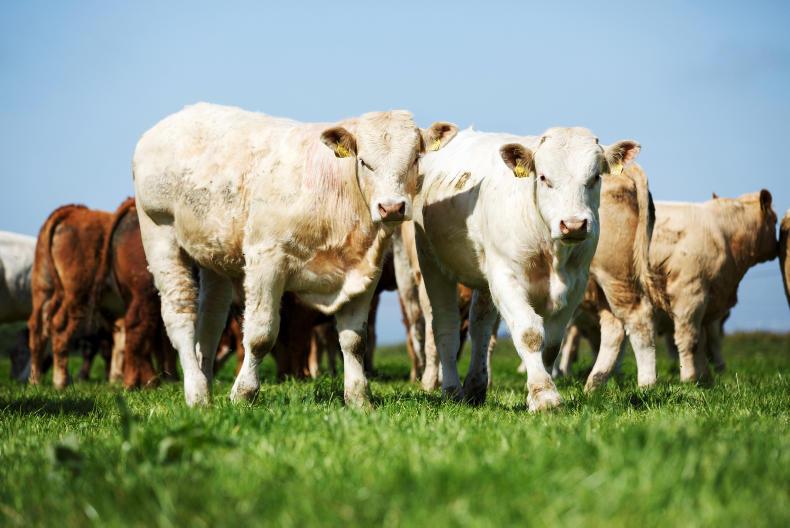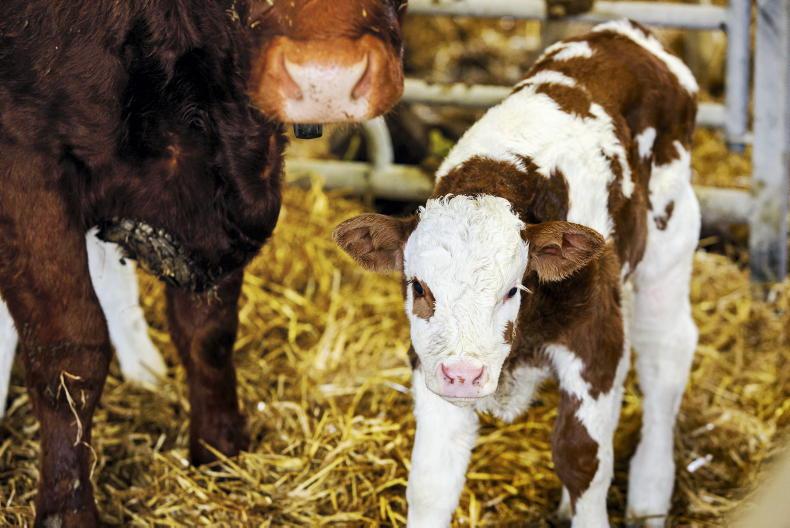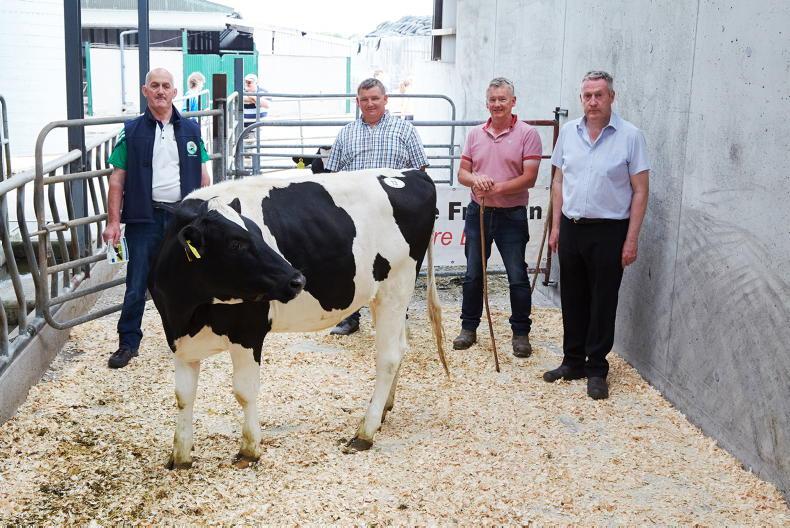The objective of the Beef Environmental Efficiency Pilot (BEEP) scheme is to increase the economic and environmental efficiency of Ireland’s suckler herd. It focuses solely on improving the weaning efficiency of suckler cows by collecting liveweights of them and their calves pre-weaning.
After full compliance with the terms of the scheme, all participants will receive a payment of €40/calf.
During the three-week application period in February, just over 18,500 farmers applied to the scheme. This figure includes all of the Teagasc/Irish Farmers Journal BETTER farm beef challenge participants.
Weaning performance report
Aside from the €40/calf payment, participants should put a value on the information obtained through weighing cows and their calves. Once weights are recorded and given to ICBF, farmers will have access to a weaning performance report.
Once generated, this report will then provide farmers with detailed information on two key areas: calf performance and cow performance.
When talking about calf performance, the two key measurements are the animal’s weight and average daily gain (ADG) from birth.
The report uses a standardised 200-day weight parameter. It suggests a target weight of 300kg for male calves and 250kg for female calves at 200 days.
The figure I like to look at is ADG. Assuming a 50kg birthweight for males, this corresponds to a target ADG of 1.25kg. To be fair, this is near the upper end of the ADG target for bull calves. Above 1.1kg/day is considered good performance, with 1.3kg being the gold standard.
The cow performance section is where BEEP comes into play
Likewise in heifer calves, assuming a 45kg birthweight, target ADG is slightly over 1kg. Again, anything over 0.95kg is good, but everyone should strive to achieve 1.1kg/day.
The cow performance section is where BEEP comes into play. The 200-day weight of a calf is taken from section I and compared to its dam’s liveweight in section II. This generates a weaning efficiency value, ie the percentage of a cow’s own weight that she produces in the form of a calf. In Ireland, the current target is 42%. The end goal should be 50%.
Without doubt, the report should be viewed as a very beneficial tool. An overview of herd performance is given, as well as an in-depth analysis of each cow and calf pair.
Study the report, look at the areas for improvement and avail of the full value of BEEP – not just the €40/calf.
Here we look at two autumn-calving farms where BEEP weights have already been submitted.

Maurice Hearne - WaterfordThe system here is under-16-month bull beef and heifer beef. The cow type is primarily first-cross and second-cross off the dairy herd, but there is a rich vein of continental breeding present too. A combination of maternal (AI Simmental and Limousin) and terminal (two Charolais stock bulls) breeding allows Maurice to breed replacements and maintain the beef merit of the herd. Twice-a-day suckling is also boosting weaning weights on the farm: “They are let in to suckle in the morning, they go out to grass for the day and they come back in to suck again in the evening, before being shut away for the night.”
Weaning is almost stress-free as the bond is broken from and early stage. Looking at the weaning performance report, Maurice’s is almost perfect. His cow weaning efficiency figure of 47% is the standout, underpinned by light but effective dairy-cross cows. Looking at the calf weights, these cows are clearly producing ample milk, all the more impressive given they are suckling indoors mostly. Perhaps the extra focus on breeding and the increasing use of AI can generate an extra 0.1kg/day.

Sean Hayes – ClareSean Hayes is also running an under-16-month bull beef system and a 20- to 22-month heifer beef system. The cow type on this farm is continental, combined with a number of Limousin dairy-cross cows. Just like Maurice, he is breeding replacements from within his own herd, and a mix of maternal and terminal sires are used.
Traditionally a weanling seller, he moved to beef finishing to maximise the return from the emphasis that had been placed on breeding. Weaning weights have always been strong, particularly for male progeny, so bull beef was an obvious choice. Often farmers look at bull beef systems as a quick-fix for making more money. The reality is that if weaning weights and performance are not up to scratch, bull beef will leave you no better off.
With Sean’s autumn calves, a 200-day male weight of 313kg, driven by an ADG of 1.33kg, is exceptional. Perhaps an area for improvement is heifer weights, where at least 1.05kg/day should be the target, particularly if 24-month calving is desired. Cow weaning performance is spot on at 43%.
Adviser comment
Tommy Cox, Teagasc
With the significant costs associated with keeping a suckler cow, a high level of performance is required from her throughout the year in order to provide a return. Farmers participating in BEEP should be using the weaning efficiency report to assess calf and, more importantly, cow performance. The report clearly indicates the high- and low-preforming cows in terms of ADG in calves up to weaning, expressed in a weaning percentage figure. This information should then be used when selecting cows for culling, or breeding stock going forward. The ultimate aim is to assemble a herd of cows with the ability to produce heavy weanlings, thus generating a higher weaning efficiency figure.
The objective of the Beef Environmental Efficiency Pilot (BEEP) scheme is to increase the economic and environmental efficiency of Ireland’s suckler herd. It focuses solely on improving the weaning efficiency of suckler cows by collecting liveweights of them and their calves pre-weaning.
After full compliance with the terms of the scheme, all participants will receive a payment of €40/calf.
During the three-week application period in February, just over 18,500 farmers applied to the scheme. This figure includes all of the Teagasc/Irish Farmers Journal BETTER farm beef challenge participants.
Weaning performance report
Aside from the €40/calf payment, participants should put a value on the information obtained through weighing cows and their calves. Once weights are recorded and given to ICBF, farmers will have access to a weaning performance report.
Once generated, this report will then provide farmers with detailed information on two key areas: calf performance and cow performance.
When talking about calf performance, the two key measurements are the animal’s weight and average daily gain (ADG) from birth.
The report uses a standardised 200-day weight parameter. It suggests a target weight of 300kg for male calves and 250kg for female calves at 200 days.
The figure I like to look at is ADG. Assuming a 50kg birthweight for males, this corresponds to a target ADG of 1.25kg. To be fair, this is near the upper end of the ADG target for bull calves. Above 1.1kg/day is considered good performance, with 1.3kg being the gold standard.
The cow performance section is where BEEP comes into play
Likewise in heifer calves, assuming a 45kg birthweight, target ADG is slightly over 1kg. Again, anything over 0.95kg is good, but everyone should strive to achieve 1.1kg/day.
The cow performance section is where BEEP comes into play. The 200-day weight of a calf is taken from section I and compared to its dam’s liveweight in section II. This generates a weaning efficiency value, ie the percentage of a cow’s own weight that she produces in the form of a calf. In Ireland, the current target is 42%. The end goal should be 50%.
Without doubt, the report should be viewed as a very beneficial tool. An overview of herd performance is given, as well as an in-depth analysis of each cow and calf pair.
Study the report, look at the areas for improvement and avail of the full value of BEEP – not just the €40/calf.
Here we look at two autumn-calving farms where BEEP weights have already been submitted.

Maurice Hearne - WaterfordThe system here is under-16-month bull beef and heifer beef. The cow type is primarily first-cross and second-cross off the dairy herd, but there is a rich vein of continental breeding present too. A combination of maternal (AI Simmental and Limousin) and terminal (two Charolais stock bulls) breeding allows Maurice to breed replacements and maintain the beef merit of the herd. Twice-a-day suckling is also boosting weaning weights on the farm: “They are let in to suckle in the morning, they go out to grass for the day and they come back in to suck again in the evening, before being shut away for the night.”
Weaning is almost stress-free as the bond is broken from and early stage. Looking at the weaning performance report, Maurice’s is almost perfect. His cow weaning efficiency figure of 47% is the standout, underpinned by light but effective dairy-cross cows. Looking at the calf weights, these cows are clearly producing ample milk, all the more impressive given they are suckling indoors mostly. Perhaps the extra focus on breeding and the increasing use of AI can generate an extra 0.1kg/day.

Sean Hayes – ClareSean Hayes is also running an under-16-month bull beef system and a 20- to 22-month heifer beef system. The cow type on this farm is continental, combined with a number of Limousin dairy-cross cows. Just like Maurice, he is breeding replacements from within his own herd, and a mix of maternal and terminal sires are used.
Traditionally a weanling seller, he moved to beef finishing to maximise the return from the emphasis that had been placed on breeding. Weaning weights have always been strong, particularly for male progeny, so bull beef was an obvious choice. Often farmers look at bull beef systems as a quick-fix for making more money. The reality is that if weaning weights and performance are not up to scratch, bull beef will leave you no better off.
With Sean’s autumn calves, a 200-day male weight of 313kg, driven by an ADG of 1.33kg, is exceptional. Perhaps an area for improvement is heifer weights, where at least 1.05kg/day should be the target, particularly if 24-month calving is desired. Cow weaning performance is spot on at 43%.
Adviser comment
Tommy Cox, Teagasc
With the significant costs associated with keeping a suckler cow, a high level of performance is required from her throughout the year in order to provide a return. Farmers participating in BEEP should be using the weaning efficiency report to assess calf and, more importantly, cow performance. The report clearly indicates the high- and low-preforming cows in terms of ADG in calves up to weaning, expressed in a weaning percentage figure. This information should then be used when selecting cows for culling, or breeding stock going forward. The ultimate aim is to assemble a herd of cows with the ability to produce heavy weanlings, thus generating a higher weaning efficiency figure.











SHARING OPTIONS